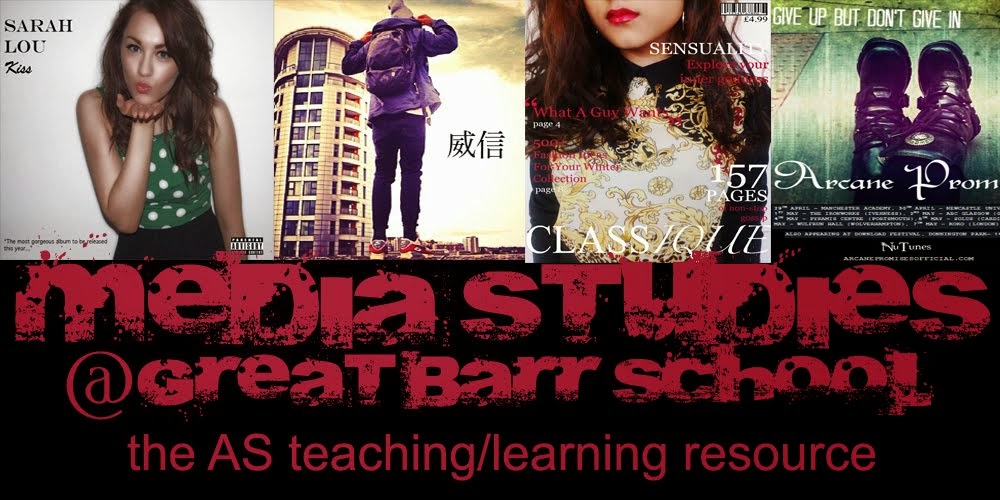media studies

student work 2012/14
Thursday 17 December 2015
Thursday 10 December 2015
LESSON 125315: FEELING THE BENEFIT

This lesson we're moving forward to explore the application of theories.
Learning the theory is good, essential even. However, you need to show the examiner that you understand the theory and this can only ever be achieved by applying the theoretical concept to an actual media product.
today we're going to take the theoretical model of Blumler and Katz of USES AND GRATIFICATIONS and apply them to the opening credits of a TV programme.
You need to keep in mind two issues - [1] you need to know the theory and [2] you need to remember the model of approaching media product analysis that we have learned in previous lessons :
- what is it?
- who is it aimed at?
- what expectations do they have?
- does the product meet these?
- how?
- what is the impact of this?
In applying these to Benefits Street we will also encounter the development of the next vital theoretical model.
LESSON 125215: BEING NEEDED
This lesson is all about possibly one of the most useful theoretical models of media audience theory - Blumler and Katz USES AND GRATIFICATIONS

Uses and Gratifications Theory is an approach to understanding why people actively seek out specific media outlets and content for gratification purposes. The theory discusses how users proactively search for media that will not only meet a given need but enhance knowledge, social interactions and diversion
The second major idea
of the mass audience theory was that the mass were all watching the same text. This suggests
that a film will be the same for every person who watches it.
A basis of Media Studies is that each of us has an individual way of seeing any media text, we
experience the same text in very different ways- so different it could almost be another text. The messages of film [and other media texts]
are received by audiences who are not an anonymous mass but a collection of
individuals with their own hopes, dreams, beliefs, desires, needs.
This lead to research into WHY
people watch specific films or types of media text

Uses and Gratifications Theory is an approach to understanding why people actively seek out specific media outlets and content for gratification purposes. The theory discusses how users proactively search for media that will not only meet a given need but enhance knowledge, social interactions and diversion
It assumes that members of the
audience are not passive but take an active role in interpreting and
integrating media into their own lives.
The theory also holds that audiences are responsible for choosing media to meet
their needs. The approach suggests that people use the media to fulfil specific
gratifications.
In 1944 Herta Herzog began
classified the reasons why people chose types of media. She interviewed radio
soap opera fans and identified three types of gratifications based on why
people listened to soap operas : emotional, wishful thinking, learning
In 1970 Abraham Maslow suggested a Uses and
Gratifications Theory as an extension of
the Needs and Motivation Theory. The basis for his argument was that people
actively looked to satisfy their needs based on a hierarchy. The pyramid
hierarchy began on the bottom with Biological/Physical, Security/Safety,
Social/Belonging, Ego/Self-Respect and Self-actualization at the top
LESSON 125115: ONE STEP BEYOND
The idea suggests that because we often watch the media
independently, it has more chance of affecting us. [Certainly
many parents think this is true and will make a point of sitting with their
young children while they watch potentially disturbing programmes so that they
can have some influence on the way the children take in the messages and
explain confusing issues, but do adults need to be protected in the same ways?]
Some critics of the idea of the mass audience have pointed out
the many ways that individuals who watch programmes alone will then share their
experience with others in conversations about what they have seen. One argument
is that these kind of conversations have much more influence on
potential behaviour than the programme.
THIS THE 2 STEP-FLOW THEORY
The 2-step flow
As the mass
media became an essential part of life in societies around the world and did
NOT reduce populations to a mass of unthinking drones, a more sophisticated
explanation was sought.
Paul Lazarsfeld, Bernard Berelson, and Hazel Gaudet analysed voters' decision-making processes during a 1940
presidential election campaign. Their findings suggested that the information does not flow directly from the text into the minds of its
audience unmediated but is filtered through "opinion leaders" who then communicate it to their less
active associates, over whom they have influence. The audience then mediate the
information received directly from the media with the ideas and thoughts
expressed by the opinion leaders, thus being influenced not by a
direct process, but by a 2-step flow.
Think
about this honestly- are your opinions about television, films, music etc ever
influenced by other people? Who? How?
Going a stage
further- do you think a friend's ideas about a media text could ever effect
your behaviour in any way?
There is some
suggestion that what happened in the James Bulger case is that Venables or
Thompson talked about a film they had seen [Child’s
Play] and influenced the
other's behaviour
LESSON 125015: ARE YOU SENSITIVE
DESENSITISATION:
GENTILE:
n
an experiment to determine the effects of violent video games causing
physiological desensitization to real-life violence, participants played either
a violent or non-violent video game for 20 minutes. After that, they watched a
10 minute video containing real-life violence while their heart rate and
galvanic skin responses were being monitored. The participants who played
violent video games previously to watching the video showed lower heart rate
and galvanic skin response readings compared to those who had not played
violent video games displaying a physiological desensitization to violence
Children
are exposed to outlets of media more and more in their everyday lives. The violent and inappropriate things that
they see through these forms of media desensitize them and have a large
negative impact on their everyday lives. Desensitization to violence is a
subtle, almost incidental process which may occur as a result of repeated
exposure to real-life violence, as well as exposure to media violence.
Emotional desensitization is evident when there is numbing or blunting of
emotional reactions to events which would typically elicit a strong response.
Cognitive desensitization is evident when the belief that violence is uncommon
and unlikely becomes the belief that violence is mundane and inevitable
The "hypodermic
needle theory" implied mass media had a direct, immediate and powerful effect on its audiences.
The mass media in the
1940s and 1950s were perceived as a powerful influence on behavior change.
Several factors
contributed to this "strong effects" theory of communication,
including:
•- the fast rise and
popularization of radio and television
•- the emergence of
the persuasion industries, such as advertising and propaganda
•- the Payne Fund studies of the 1930s,
which focused on the
impact of motion pictures on children
•- Hitler's
monopolization of the mass media during WWII to unify the German public behind
the Nazi party
Tuesday 1 December 2015
Subscribe to:
Posts (Atom)



